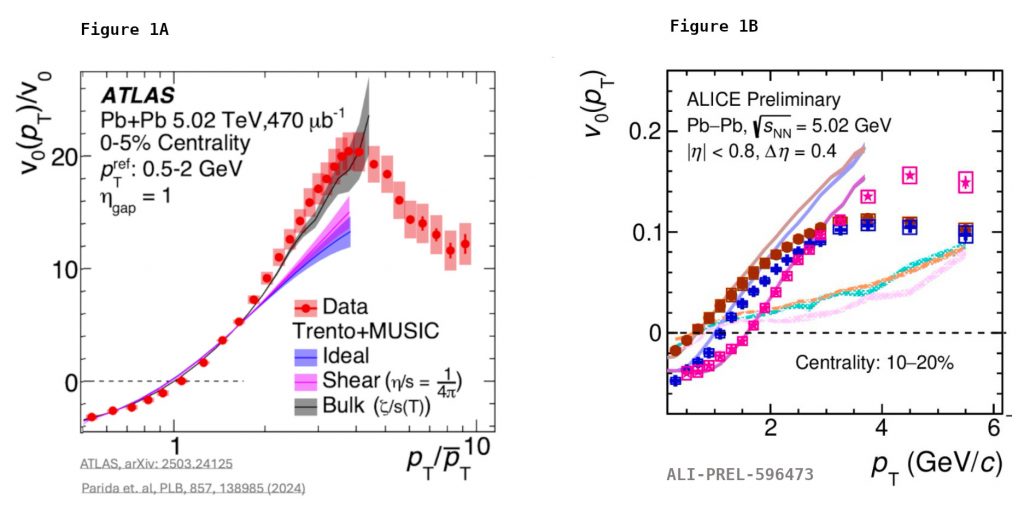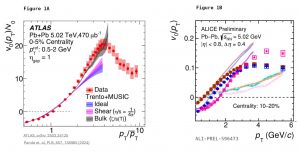The ATLAS and ALICE collaborations at the LHC have recently presented results on the observation of the collective fluid behavior of quarks and gluons in heavy-ion collisions, obtained using a new observational method suggested by theorists from the Institut de Physique Théorique.
At CERN’s Large Hadron Collider (LHC) lead atom nuclei, accelerated in opposite directions, collide at speeds close to the speed of light. In such scattering processes, the quarks and gluons that make up these nuclei collide, creating other quarks and gluons, produced by the fundamental interaction known as the “strong interaction”. The number of particles created is around one hundred times greater than the initial number.
As the particles created are numerous and interact strongly with one another, emergent phenomena arise: the whole is more than the sum of its parts. More precisely, the thirty thousand or so created particles form a fluid (a droplet of femtoscopic size — 10^-14 m), where their individuality disappears. This description has the advantage of simplicity, as the fluid is characterized by a handful of parameters: temperature (around 2,500 billion degrees) and velocity.
In 2024, theorists at the Institut de Physique Théorique of CEA Paris Saclay, proposed a new method for observing this so-called “collective” behavior [1]. Their method has just been implemented by two of the LHC’s four major experimental collaborations, ATLAS [2] and ALICE [3], whose results were presented at the major international conference “Quark Matter 2025”, which brought together almost a thousand scientists in Frankfurt in early April.
The principle of the method is to exploit the small temperature variations, of the order of a percent, from one collision to the next. The temperature is not exactly the same in all collisions, but it is homogeneous in each collision. This implies that particles emitted at different angles to the beam direction come from a fluid at the same temperature. In other words, temperatures measured in different directions are correlated. The ATLAS collaboration, whose detector has excellent angular coverage, verified that this correlation was independent of the relative angle between the emitted particles [2], confirming the hypothesis of a homogeneous temperature.

Figure 1: Relative variation, dubbed v0(p_T), in the spectrum of emitted particles resulting from a temperature variation, measured by ATLAS (A) and ALICE (B). p_T denotes the momentum projected perpendicular to the beam axis. ALICE can identify the three most common types of particle — pions, kaons and protons — and performs measurements for all three. ATLAS does not identify particles, and performs an averaged measurement over the different types. Symbols correspond to experimental results, and lines to hydrodynamic model predictions. In the case of ALICE, the predictions of traditional particle physics models, which do not take fluid formation into account and are falsified by the measurement, are also shown in lighter colors.
The experiments also measured the variation in the “spectrum” of emitted particles (the probability law of momentum) resulting from a small increase in temperature. A warmer fluid produces fewer slow-moving particles and more fast-moving ones (Figure 1). The results are in quantitative agreement with hydrodynamic predictions [1], except for the very fast particles, which represent only a tiny fraction of the whole, and which are thought to be emitted in the very first moments of the collision, before the formation of the fluid.
[1] Tribhuban Parida, Rupam Samanta, Jean-Yves Ollitrault, “Probing collectivity in heavy-ion collisions with fluctuations of the pT spectrum”, Phys.Lett.B 857 (2024) 138985. https://arxiv.org/abs/2407.17313
[2] ATLAS Collaboration, “Evidence for the collective nature of radial flow in Pb+Pb collisions with the ATLAS detector”. https://arxiv.org/abs/2503.24125
[3] ALICE Collaboration, “Long-range transverse momentum correlations and radial flow in Pb−Pb collisions at the LHC”. https://arxiv.org/abs/2504.04796
[4] Björn Schenke, Chun Shen, Derek Teaney. “Transverse momentum fluctuations and their correlation with elliptic flow in nuclear collision”. Phys.Rev.C 102 (2020) 3, 034905. https://arxiv.org/abs/2004.00690


